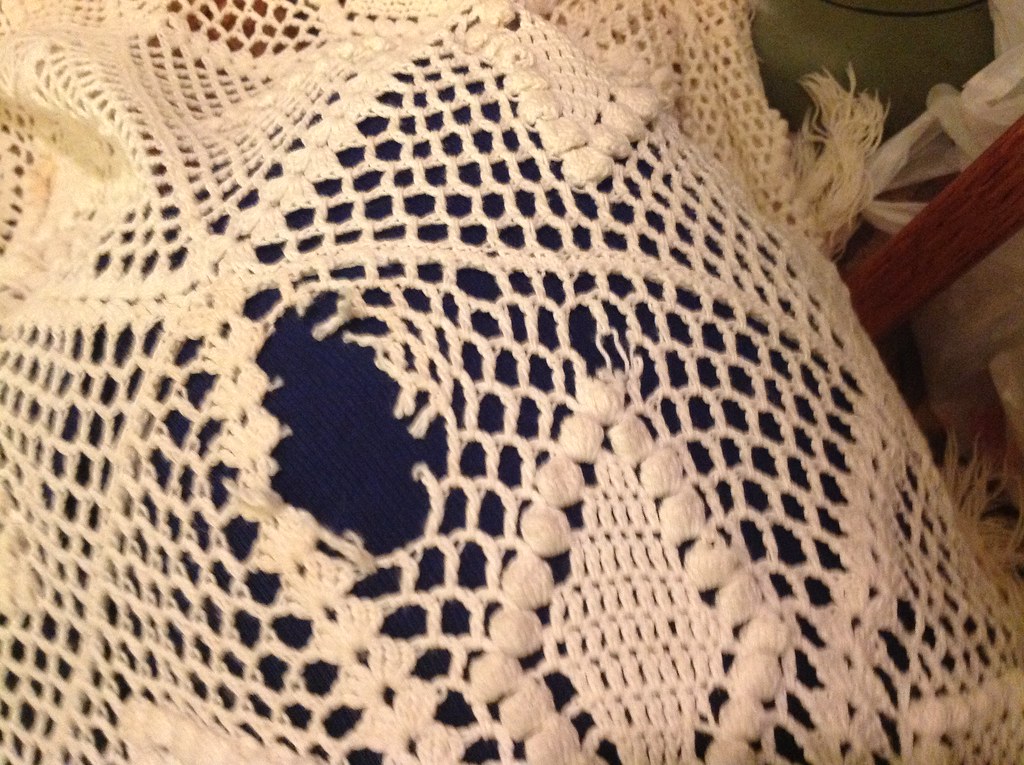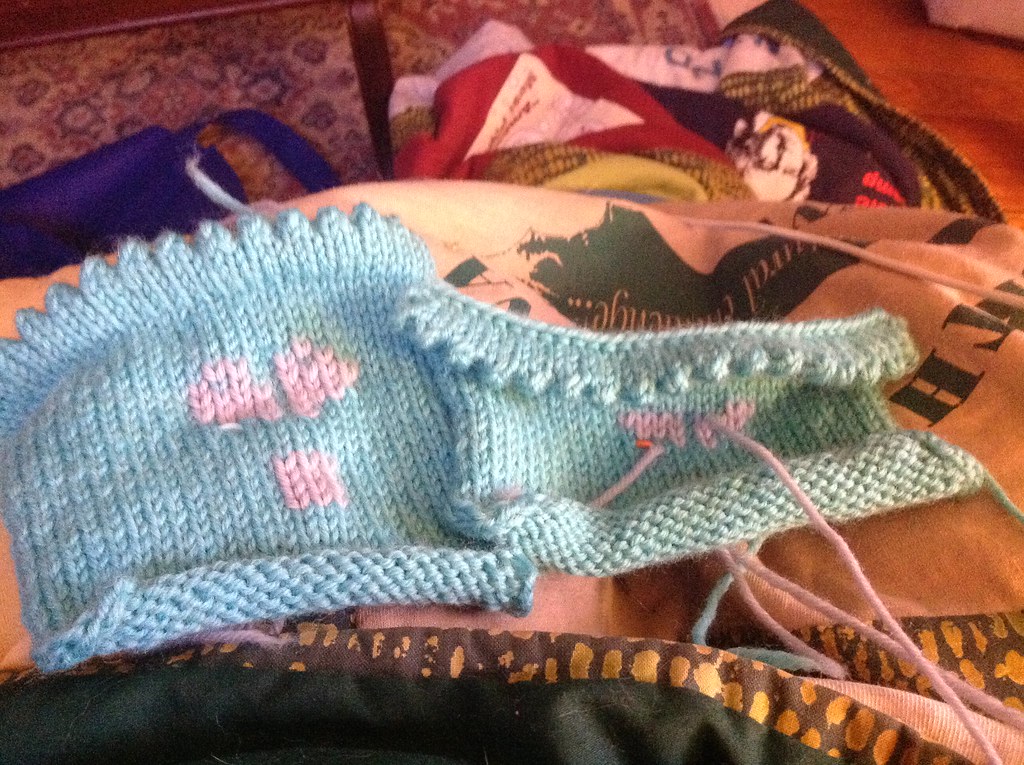As I mentioned earlier this week, I’ve been hopping, trying to wrap up finishing projects before Christmas is truly upon us. I’ve nearly pushed through the projects that are due in the next two weeks (and then the rest aren’t due until the New Year!). I had one repair in particular that I wanted to share – a sweater repair in the Irish Knit Style. The owner, AM, discovered me through the Washington Post article, and got in contact with me shortly thereafter. She had a hole right in the front of the sweater, and could I please repair it?
As always, I told her I’d do the best I was able, but I was concerned – the yarn she had, a cream flecked with bits of brown, looked to be tricky to match.
This week I sat down to start on her repair, and when I pulled her sweater out of my bag, I couldn’t help wincing – this yarn was going to be really tricky to match. I have a number of different creams on hand, but all of them were too light, and with too much “yellow” undertone. AM’s sweater was a cream with an almost grey undertone. And again, it had flecks of brown it it – tricky to match. I checked the sweater – there wasn’t a good place to “harvest” yarn without going to a lot of effort, and I knew AM wanted to keep the costs down. So matching the yarn from somewhere else would be a better option.
The hole itself was a lucky one: a row higher and it would be in the middle of a cable – a repair that’s much more finicky and tedious to do. Two rows down there was the same problem. This hole happened in exactly the right place – the few rows between two cables.
Well, it’d been a while since I’d been to one of the local yarn stores. I figured it was time for a visit.
The Knitting B is a local yarn store about 25 minutes from where I live. It’s the longest drive to a LYS I’ve had since I left my parents’ house. So I don’t get there as often as I feel I should, and it’s too bad. It’s a great store with lots of natural light, a solid selection of yarns, and a good parking area (always a plus!). Elizabeth, the owner, had an LYS in Charlottesville, VA for 25 years. She’s a savvy businesswoman who knows here stuff.
When I got to the Knitting B one of the employees began helping me out trying to get a match. Everything we pulled was not right. Many of my go-to’s weren’t working. And then, I remembered a trick I’d used before to get a good match. Color changing yarns often will have sections that shift between colors, which means you get a lot of “bang” for your buck – and in this case, a couple of yards of yarn that match a hard to match yarn. In this case, Noro Silk Garden came to the rescue.
The repair was pretty standard after that.
Because the yarn was awfully fuzzy, and hard to see what I was doing, I did a step I sometimes skip. I ran guidelines: a different color of crochet thread for each row. Because it’s the holidays, I decided to go with red and green. I then unpicked the old yarn, pulling it out of the way.
I began tracing the yarn with the Noro Silk Garden. My only complaint about Noro is that it’s really easy to pull apart, being a single-ply. It was also a fraction less lofty than the original yarn, but the color matching was so perfect I didn’t care, as the repair was only 4 stitches across. I ran the first row of yarn, adjusting the stitches to make sure they matched the gauge of the stitches around them. Then I pulled out the green guideline. It’s one of the reasons I love crochet cotton: it pulls out REALLY easily, and is nearly unbreakable without scissors.
I then ran the second set of yarn, and pulled out the red yarn.
See how nice the color match is? Just let me be geeky for a moment – the under-color is SO close, and the flecks of brown is SOOO close too. You’d really have to be looking to notice this.
Then got down to the tedious part: weaving in the old ends and the new ends, tweaking things as I go.
Can you spot the repair? Yes? Well then, I ask you.
How about now?
As always, if you’re looking to have a knit piece repaired, get in touch with me on my Finishing Page. Got questions? I’d love to hear from you. Comment, or drop me a note!


















 Meanwhile, I’m also looking at the practical part of the project. How damaged is the item? How widespread is the wear? Would attempting to fix the item hurt things further? When I’m looking into this I’m often learning about the history of the item: if it was stored in a place where a lot of sunlight, heat or humidity could get to it, the fibers may be damaged. Are the places where wear is showing from use – such as worn out fingers on mittens, or a handle on a bag becoming worn, or because of a different factor? Often the answers form the type of repairs I can do – mittens that are going to get further wear over each winter are going to receive different treatment than a Christmas stocking that’s taken out once a year.
Meanwhile, I’m also looking at the practical part of the project. How damaged is the item? How widespread is the wear? Would attempting to fix the item hurt things further? When I’m looking into this I’m often learning about the history of the item: if it was stored in a place where a lot of sunlight, heat or humidity could get to it, the fibers may be damaged. Are the places where wear is showing from use – such as worn out fingers on mittens, or a handle on a bag becoming worn, or because of a different factor? Often the answers form the type of repairs I can do – mittens that are going to get further wear over each winter are going to receive different treatment than a Christmas stocking that’s taken out once a year.
 Quick Crochet Vest: Learn Broomstick Lace, Short-Rows, Back Loop Stitches & More
Quick Crochet Vest: Learn Broomstick Lace, Short-Rows, Back Loop Stitches & More



 Intarsia Wrap
Intarsia Wrap
